Meet the pygmy rabbit: the smallest rabbit species in the world, a creature that only thrives in the biggest, healthiest sagebrush and one of the hardest-to-spot critters in North America.
I’ve searched for them in sagebrush country for years but never caught so much as a glimpse.
Recently, I got a tip on a spot in southwestern Wyoming where the little rabbits thrived. That sounded like the perfect excuse for a 4th of July holiday road trip.
I found a great and little-visited national monument where you can indeed spot pygmy rabbits, as well as a lot of other sagebrush-dependent wildlife.
But first, a little natural history on this interesting animal.
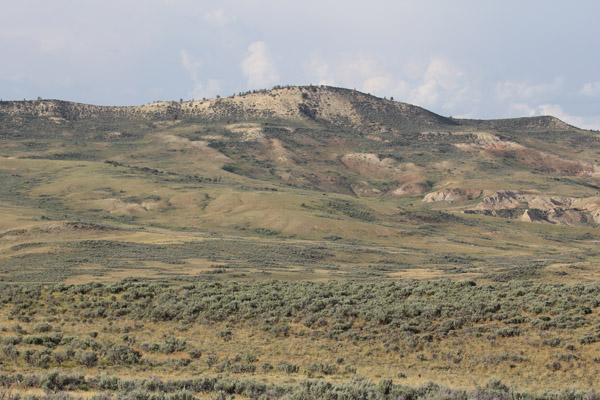
Tiny Rabbit in the Big Sage
Pygmy rabbits require a very specific habitat: big sagebrush. Some research has indicated they do best in sagebrush that is six feet or more in height.
Such habitat was once common in many western states. Today, most of that healthy habitat has been lost to fire, non-native weeds, juniper encroachment, unsustainable grazing and energy development.
The little rabbits have habits quite different from other rabbit and hare species in North America. Most rabbits don’t actually dig their own holes; they utilize vacated holes dug by badgers, marmots and other mammals. Not so with pygmy rabbits. They dig their own holes under their favorite plant, big sagebrush.
They are quite adept burrowers. In parts of their range, the snow can get quite deep, so the pygmy rabbit digs a network of trails under the snow to get from one brush to the next.
Most conservationists believe these little rabbits have been greatly reduced in population. That makes sense, given their loss of habitat. But there is surprisingly little scientific research on their exact status. While there have been petitions to list them under the Endangered Species Act, none of these efforts has succeeded.
There is a genetically distinct population of pygmy rabbits in Washington, known as Columbia Basin pygmy rabbits, that has been the subject of considerable conservation effort.
In 2002, only 16 of these animals remained. A captive breeding effort was launched to save them. The first release in 2007 resulted in all the rabbits being eaten by predators – the zoo-born animals were not ready for life in the wild.
The breeding effort continues, but conservationists are now rearing pygmy rabbits in open enclosures to better acclimate them to natural conditions.
The Nature Conservancy purchased the Beezley Hills Preserve in Washington in part as potential pygmy rabbit habitat.
Elsewhere, the difficulty in assessing populations is likely in part because pygmy rabbits are difficult to find and observe. They have small home ranges; researchers have found they don’t venture more than 100 meters from their den. Big, dense sagebrush is also not the easiest place to see a tiny and elusive critter.
For wildlife watchers, they can almost seem like little gnomes of the high desert: you will often hear people say they are found on this reserve or that butte, but when you go, you never find them.
Earlier in the summer, Canadian biologists and mammal enthusiasts Dave Robichaud and Melissa Frye told me of a spot where pygmy rabbits could be reliably seen.
And so, over the holiday weekend, my wife and I made our way to southwestern Wyoming, to Fossil Butte National Monument.
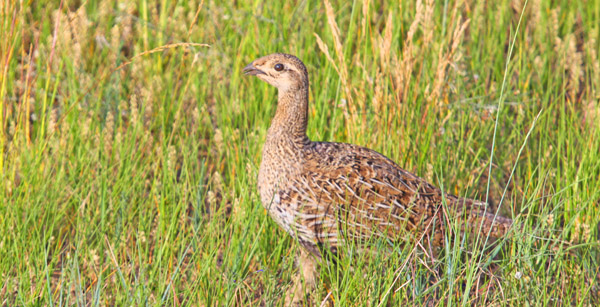
The Sagebrush Critters of Fossil Butte
I’m not sure why more people don’t know about Fossil Butte. Maybe it’s the remote location. Or maybe it suffers being in a state and region with a plethora of natural wonders.
The national monument was established to protect the fossil beds on the property. Once this area was covered by a lake, and more similar to Central American forest than the arid sagebrush country of today.
The visitor center displays an impressive array of fossils, especially large fish including some of my favorites like gar and paddlefish. On Fridays and Saturdays, you can watch paleontologists excavating fossils.
This isn’t just a fossil park. The sagebrush on the national monument has not been grazed or disturbed since the 1970s. While there are some weeds, the habitat is in remarkably good condition.
Big sagebrush, bunch grasses, wildflowers: healthy high desert country at its finest.
And where’s there’s great habitat, wildlife thrives: pronghorn, white-tailed prairie dog, Wyoming ground squirrel, greater sage grouse and sage thrasher, among many others.
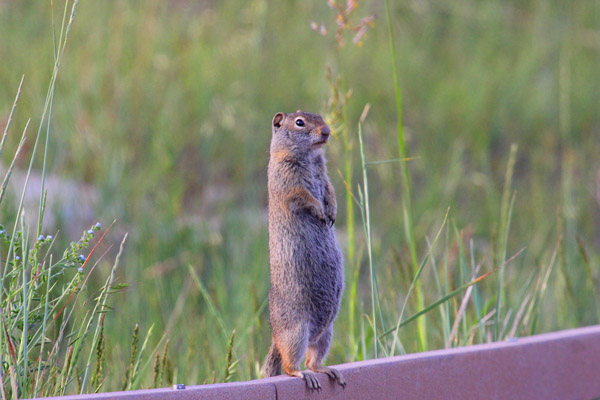
Robichaud had advised me to check out the patch of sagebrush around the visitor center for pygmy rabbits. I inquired with a refuge volunteer, who acted as if I had asked him where to spot sasquatches. A refuge staffer informed me that there was indeed a colony of pygmy rabbits around the center.
These rabbits are crepuscular (they’re primarily active at dawn and dusk). So at dusk, we returned to the parking lot.
And sure enough, just before dusk, a pygmy rabbit appeared. Right in the parking lot. It was not a wilderness sighting, but it was great to observe the animal clearly through binoculars.
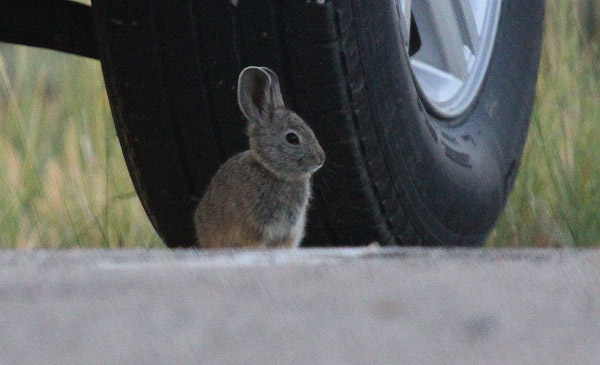
Pygmy rabbits are pretty easy to tell from the more-common mountain cottontails that share their range. First, pygmy rabbits don’t have the white “cotton” tail. If you see white, it’s not a pygmy.
They also have a grayer, dustier appearance. And of course, they’re a lot smaller. If you have seen many rabbits, you’ll see the difference right away.
We returned the next evening and saw three more pygmy rabbits.
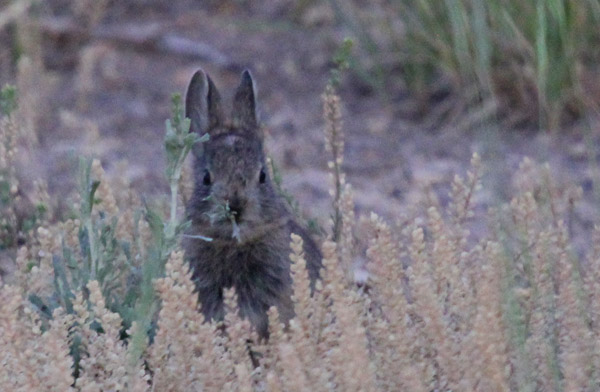
The national monument attracts visitors to the fossil beds, but we often felt like we had the whole place to ourselves as we photographed wildlife, hiked and enjoyed the scenery.
I often hear people describe sagebrush country as “boring” – they drive by the desert going 75 on the interstate, and they see only monotonous brush.
Take a walk in healthy habitat and you’ll feel differently – the color of the wildflowers and diversity of the wildlife makes the high desert pop to life. There aren’t many places better than Fossil Butte for that experience. Hopefully you too will be rewarded with a sight of the tiniest rabbit on earth.

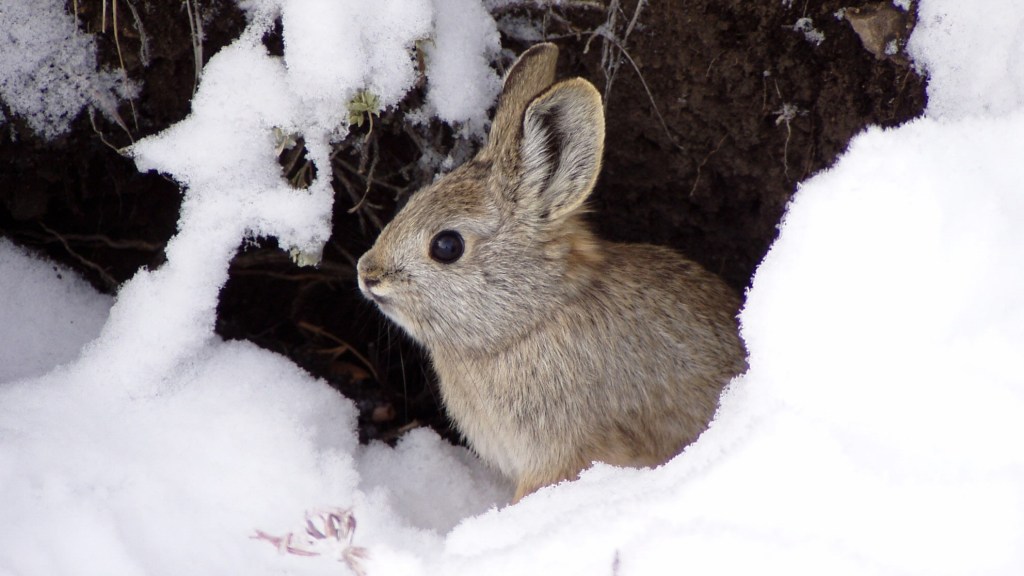



There’s even more thriving out in the Moxa Arch area, east of Kemmerer. Biological consultants performing black-footed ferret surveys would often fine 10’s or sometimes over 100 pygmy rabbits in a single night of surveying. Lots of cottontails and white-tailed jackrabbits too. At times up to 200-300 of each. BLM land so it’s open to the public. Best place to look is north of Hwy 30 and in the Cow Hollow and Shute Creek areas. You can usually find their burrows in sand dunes under hopsage, sage brush, and other brushes. Just look for the BB sized pellets at the bottom of a dune.
Hi Matt,
Earlier this week (1/20/16) I got your e-mail with the subject line “Science Update: Pygmy Rabbit Rescue.” The mail re-posted an article by Beth Geiger about the work of re-establishing pygmy rabbits in Eastern Washington. A good part of the article concerns a breeding enclosure on my property, although I am never mentioned. This breeding enclosure is the first private/public venture in Washington State for such purposes. I applied for and received a grant to build it in complete cooperation with Washington Department of Fish and Wildlife. I just wanted to say that I am a long-time TNC member. The fact is that all of the pygmy rabbits released to TNC lands in the Beezley Hills area have come from the breeding enclosure on my property. I really hope that in 2016 we can have as much success as in 2015 in releasing rabbits to the Beezley Hills area. Regards, Peter.
By the way, I’ve been to Fossil Butte a couple of times, once in late winter when the white-tailed jack rabbits still had their white pelage. Someone should do a piece on that interesting animal…
Hi,
Thank you for your concern for wildlife in the United States. I’d never heard of a “pygmy rabbit” until I saw the email this morning from the Nature Conservancy. What a nice article and what adorable photographs of this tiny, beautiful little creature. What a gift that you and the others had a chance to observe it in its natural home — even if one the little rabbits took refuge temporarily right under someone’s car or truck just like we might look for shade under the trees or cooler temperatures where we could find them.
Thank you for all of your hard work as you collaborate with others to assist the most innocent, lovely and fragile of creatures that all of us enjoy. It’s great when folks recall that we are guests in their home, the one that all of us share known as God’s beautiful blue and green planet. Thanks again for taking the time to write this article, take the trip to observe the wildlife, etc., and for all of your work there at the Nature Conservancy. It is very much appreciated. What adorable photographs of the little, tiny rabbits. Beautiful little creatures, huh?
Best,
Barbara D. Day
Arlington, VA
Lame!
The latest captive breeding program in Washington has included rabbits other than Columbia Basin as the lack of genetic diversity had caused breeding problems. The survival rates have increased and they’ve begun breeding in the wild.
http://wdfw.wa.gov/conservation/pygmy_rabbit/
Hi Ginger,
Yes, the Columbia Basin pygmy rabbits (those found in Washington) are endangered, but the overall population is not listed.
Dana,
According to the Oregon Zoo, they have full Washington pygmy rabbits. I will double check.
Thanks everyone for reading the blog! Best, Matt
Last time I checked, the Washington State population of pygmy rabbits was officially extinct. A breeding program had incorporated some Idaho rabbits, so all remaining rabbits are only part Washington pygmies. Still cute as buttons, though.
Delightful did not know the existed so small–pygmy rabbits!
Hi Matt, I enjoyed your article. Pygmy rabbits are listed by the USFWS as endangered in Washington State, so you might want to correct your blog. Here’s a link to some information:
http://www.fws.gov/nevada/nv_species/pygmy_rabbit.html
Even though I lived in Colorado for 23 years and visited Wyoming, Utah, etc., I had never before heard of pygmy rabbits until reading your article. How awesome!
Great article as usual. Pygmy’s are indeed an odd mystery to me. I encounter them quite frequently. Many times I am so focused on Sage Grouse or chukars or quail that I do not pay them much attention and do not realize what I was seeing until they turn and run there is no flash of cotton tail. I need to pay more attention when I have my camera in hand.
Thank you for such a delightful story and great pictures.
I lived in Wyoming for years and never heard of such lovely creatures.
Of course you saw it in the parking lot! So many times I have set out on long hikes in search of some rarity or another, only to return to the trail head, hours later, to finally find the prize perched on the parking lot railing, nibbling leftovers on a picnic table or preening atop the outhouse. I am sure this has more to do with the crepuscular nature of so many wild things than any perverse joy they might take in my gullibility.
Congrats on your success and many thanks to refuge staffers everywhere.
This is way cool! Glad you had a chance to visit our little piece of sagebrush country.